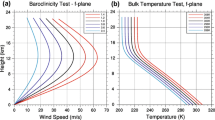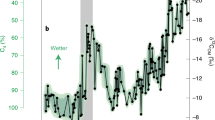Abstract
The response of midlatitude storms to global warming remains uncertain. This is due, in part, to the competing effects of a weaker meridional surface temperature gradient and a higher low-level moisture content, both of which are projected to occur as a consequence of increasing greenhouse gases. Here we address the latter of these two effects, and try to elucidate the effect of increased moisture on the development and evolution of midlatitude storms. We do this with a set of highly controlled, baroclinic lifecycle experiments, in which atmospheric moisture is progressively increased. To assess the robustness of the results, the moisture content is changed in two different ways: first by using different initial relative humidity, and second by varying a parameter that we insert into the Clausius-Clapeyron equation. The latter method allows us to artificially increase the moisture content above current levels while keeping the relative humidity constant. Irrespective of how moisture is altered, we find that nearly all important measures of storm strength increase as the moisture content rises. Specifically, we examine the storm’s central pressure minimum, the strongest surface winds, and both extreme and accumulated precipitation rates. For all these metrics, increased moisture yields a stronger storm. Interestingly, we also find that when moisture is increased beyond current levels, the resulting storm has a reduced horizontal scale while its vertical extent increases. Finally, we note that for moisture increases comparable to those projected to occur by the end of the twentyfirst century, the actual amplitude of the increases in storm strength is relatively modest, irrespective of the specific measure one uses.













Similar content being viewed by others
References
Barnes EA, Hartmann DL (2012) The global distribution of atmospheric eddy-length scales. J Clim 25:3409–3416
Bengtsson L, Hodges KI, Keenlyside N (2009) Will extratropical storms intensify in warmer climate? J Clim 22:2276–2301
Booth JF, Thompson L, Patoux J, Kelly KA (2012) Sensitivity of midlatitude storm intensification to perturbations in the sea surface temperature near the Gulf stream. Mon Weather Rev 140:1241–1256
Boutle IA, Beare RJ, Belcher SE, Brown AR, Plant RS (2010) The moist boundary layer under a mid-latitude weather system. Boundary Layer Meteorol 134:367–386
Boutle IA, Belcher SE, Plant RS (2011) Moisture transport in mid-latitude cyclones. Q J R Meteorol Soc 137:360–367
Campa J, Wernli H (2012) A PV perspective on the vertical structure of mature midlatitude cyclones in the Northern Hemisphere. J Atmos Sci 69:725–740
Carlson TN (1998) Mid-Latitude weather systems. American Meteorological Society, Boston
Catto JL, Shaffrey LC, Hodges KI (2011) Northern Hemisphere extratropical cyclones in a warming climate in the HiGEM high-resolution climate model. J Clim 24:5336–5352
Champion AJ, Hodges KI, Bengtsson LO, Keenlyside NS, Esch M (2011) Impact of increasing resolution and a warmer climate on extreme weather from Northern Hemisphere extratropical cyclones. Tellus 63A:893–906
Chen S-H, Sun W-Y (2002) A one-dimensional time dependent cloud model. J Meteorol Soc Jpn 80:99–118
Davis CA, Stoelinga MT, Kuo Y-H (1993) The integrated effect of condensation in numerical simulations of extratropical cyclogenesis. Mon Weather Rev 121:2309–2330
Emanuel KA, Fantini M, Thorpe AJ (1987) Baroclinic instability in an environment of small stability to slantwise moist convection. Part I: two-dimensional models. J Atmos Sci 44:1559–1573
Fantini M (1993) A numerical study of two-dimensional moist baroclinic instability. J Atmos Sci 50:1199–1210
Frierson DMW, Held IM, Zurita-Gotor P (2006) A gray-radiation aquaplanet moist GCM. Part 1: static stability and eddy scale. J Atmos Sci 63:2548–2566
Gastineau G, Soden BJ (2009) Model projected changes of extreme wind events in response to global warming. Geophys Res Lett 36:L10810. doi:10.1029/2009GL037500
Gutowski WJ, Branscome LE, Stewart DA (1992) Life cycles of moist baroclinic eddies. J Atmos Sci 49:306–319
Held IM, Soden BJ (2006) Robust responses of the hydrological cycle to global warming. J Clim 19:5686–5699
Holton JR (2004) An introduction to dynamic meteorology, 4th edn. Elsevier Academic, New York
Hong S-Y, Noh Y, Dudhia J (2006) A new vertical diffusion package with an explicit treatment of entrainment processes. Mon Weather Rev 134:2318–2341
Kain JS, Fritsch JM (1993) Convection parameterization for mesoscale models: the Kain-Fritsch scheme. In: Emanuel KA, Raymond DJ (eds) The representation of cumulus convection in numerical models. Amer Meteor Soc, Boston
Kidston J, Dean SM, Renwick J, Vallis GK (2010) A robust increase in the eddy length scale in the simulation of future climates. Geophys Res Lett 37:L03806
Lambert SJ, Fyfe JC (2006) Changes in winter cyclone frequencies and strengths simulated in enhanced greenhouse warming experiments: results from the models participating in the IPCC diagnostic exercise. Clim Dyn 26:713–728
Li F, Collins WD, Wehner MF, Williamson DL, Olson JG (2011) Response of precipitation extremes to idealized global warming in an aqua-planet climate model: towards a robust projection across different horizontal resolutions. Tellus 63A:876–883
Lin Y-L, Farley RD, Orville HD (1983) Bulk parameterizations of the snow field in a cloud model. J Clim Appl Meteorol 22:1065–1092
Lorenz DJ, DeWeaver ET (2007) Tropopause height and zonal wind response to global warming in the IPCC scenario integrations. J Geophys Res 112:D10119. doi:10.10292006JD008087
Mak M (1994) Cyclogenesis in a conditionally unstable moist baroclinic atmosphere. Tellus 46A:14–33
Martin J (2006) Mid-latitude atmospheric dynamics. Wiley, West Sussex
Naud CM, Del Genio AD, Bauer M, Kovari W (2010) Cloud vertical distribution across warm and cold fronts in CloudSat–CALIPSO data and a general circulation model. J Clim 23:3397–3415
O’Gorman PA, Schneider T (2009) The physical basis for increases in precipitation extremes in simulations of 21st-century climate change. Proc Natl Acad Sci 106:14773–14777
O’Gorman PA (2011) The effective static stability experienced by eddies in a moist atmosphere. J Atmos Sci 68:75–90
Pavan V, Hall N, Valdes P, Blackburn N (1999) The importance of moisture distribution for the growth and energetics of baroclinic eddies. Ann Geophys 17:242–256
Polvani LM, Esler JG (2007) Transport and mixing of chemical air masses in idealized baroclinic life cycles. J Geophys Res 112:D23102. doi:10.1029/2007JD008555
Reed RJ, Grell G, Kuo Y-H (1993) The ERICA IOP 5 storm. Part II: sensitivity tests and further diagnosis based on model output. Mon Weather Rev 121:1595–1612
Rotunno R, Skamarock WC, Snyder C (1994) An analysis of frontogenesis in numerical simulations of baroclinic waves. J Atmos Sci 51:3373–3398
Sherwood SC, Roca R, Weckwerth TM, Andronova NG (2010) Tropospheric water vapor, convection and climate. Rev Geophys 48:2009RG000301
Simmons AJ, Hoskins BJ (1978) The life cycles of some non-linear baroclinic waves. J Atmos Sci 35:414–432
Skamarock WC, Klemp JB, Dudhia J, Gill DO, Barker DM, Duda M, Huang X-Y, Wang W, Powers JG (2008) A description of the advanced research WRF Version 3, NCAR Technical Note http://www.mmm.ucar.edu/people/skamarock/
Solomon S, Qin D, Manning M, Chen Z, Marquis M, Averyt KB, Tignor M Miller HL (eds) (2007) Climate change 2007: the physical science basis. In: Contribution of working group i to the fourth assessment report of the intergovernmental panel on climate change. Cambridge University Press, New York
Stoelinga MT (1996) A potential vorticity-based study on the role of diabatic heating and friction in a numerically simulated baroclinic cyclone. Mon Weather Rev 124:849–874
Thorncroft CD, Hoskins BJ, McIntyre ME (1993) Two paradigms of baroclinic wave life-cycle behaviour. Q J R Meteorol Soc 119:17–55
Ulbrich U, Leckebusch GC, Pinto JG (2009) Extra-tropical cyclones in the present and future climate: a review. Theor Appl Climatol 96:117–131
Wang S, Polvani LM (2011) Double tropopause formation in idealized baroclinic life cycles: The key role of an initial tropopause inversion layer. J Geophys Res 116:D05108. doi:10.1029/2010JD015118
Weisman ML, Klemp JB (1982) The dependence of numerically simulated convective storms on vertical wind shear and buoyancy. Mon Weather Rev 110:504–520
Wernli H, Davies HC (1997) A Lagrangian based analysis of extratropical cyclones: the method and some applications. Q J R Meteorol Soc 123:467–490
Whitaker JS, Davis CA (1994) Cyclogenesis in a saturated environment. J Atmos Sci 51:889–907
Acknowledgments
We acknowledge the World Climate Research Programme’s Working Group on Coupled Modeling, which is responsible for CMIP, and we thank the climate modeling groups (listed in the Sect. Appendix) for producing and making available their model output. For CMIP the U.S. Department of Energy’s PCMDU provides coordinating support and led development of software infrastructure in partnership with the Global Organization for Earth System Science Portals. The work of LMP is funded, in part, by a grant from the US National Science Foundation. The work of JFB is funded by the National Aeronautics and Space Administration (NASA) postdoctoral program. SW thanks Jian Lu for discussions of experiment design at earlier phase. We thank Heini Wernli and an anonymous reviewer for useful suggestions that helped to clarify the presentation of the main points of this work.
Author information
Authors and Affiliations
Corresponding author
Appendix: Details for Fig. 8
Appendix: Details for Fig. 8
For Fig. 8, we download data from the Program for Climate Model Diagnosis and Intercomparison (PCMDI), CMIP3 archive for the IPCC AR4. We use the historical model integrations to represent the twentieth century and the runs from the Global Warming A2 scenario for the twentyfirst century. Scenario A2 from CMIP3 corresponds to an increase in global temperatures in the range from 2–5 °C. The increase in CO2 associated with this scenario seemed pessimistic when it was created in 2000, but not anymore. We chose Scenario A2 because it corresponds to a projection in which economies maintain the status quo, which doesn’t seem unreasonable.
1.1 Models used in Fig. 8
BCCR: Bergen Climate Model (BCM) project at the Bjerknes Centre for Climate Research. CCCMA: Canadian Centre for Climate Modeling and Analysis, Victoria, BC, Canada. CCSM: Community Climate System Model project, supported by the, Directorate for Geosciences of the National Science Foundation, and the Office of Biological and Environmental Research of the U.S. Department of Energy. CNRM: Centre National de Recherches Meteorologiques, Meteo-France, Toulouse, France. CSIRO: Atmospheric Research, Melbourne, Australia. ECHAM: Max Planck Institute for Meteorology, Hamburg, Germany. GFDL: US Dept of Commerce/NOAA/Geophysical Fluid Dynamics Laboratory, Princeton, NJ, USA. GISS ModelE: NASA Goddard Institute for Space Studies New York, NY, USA. INMCM: Institute for Numerical Mathematics, Moscow, Russia. IPSL: Institut Pierre Simon Laplace, Paris, France. CCSR/NIES/FRCGC: Center for Climate System Research, Tokyo, Japan/National Institute for Environmental Studies, Ibaraki, Japan/Frontier Research Center for Global Change, Kanagawa, Japan. MRI: Meteorological Research Institute, Tsukuba, Ibaraki, Japan. PCM: National Center for Atmospheric Research, Boulder, CO, USA.
Rights and permissions
About this article
Cite this article
Booth, J.F., Wang, S. & Polvani, L. Midlatitude storms in a moister world: lessons from idealized baroclinic life cycle experiments. Clim Dyn 41, 787–802 (2013). https://doi.org/10.1007/s00382-012-1472-3
Received:
Accepted:
Published:
Issue Date:
DOI: https://doi.org/10.1007/s00382-012-1472-3




